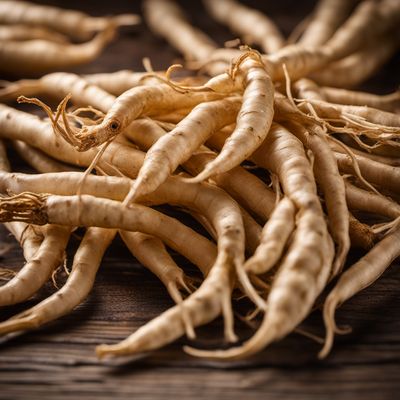
Ingredient
Ginseng and similar-
The Energizing Root
Ginseng and similar roots, including American ginseng, Asian ginseng, and Siberian ginseng, are characterized by their gnarled appearance and pale yellow color. They have a firm texture and a distinct earthy taste with slightly bitter undertones. These roots are commonly used in Asian cuisine, particularly in soups, stir-fries, and herbal teas. They are also believed to have various health benefits, such as boosting energy levels and improving cognitive function.
Origins and history
Ginseng has a rich history that dates back thousands of years. It originated in Asia, where it has been used in traditional Chinese medicine for its medicinal properties. Ginseng was highly valued and often reserved for emperors and nobility. It later spread to other parts of the world, including North America, where American ginseng became popular. Today, ginseng is cultivated in several countries, with China being the largest producer. It continues to be highly regarded for its potential health benefits and culinary uses.
Nutritional information
Ginseng and similar roots are low in calories and are a good source of antioxidants, vitamins, and minerals. They are known for their potential to boost energy levels, improve cognitive function, and support the immune system.
Allergens
Some individuals may be allergic to ginseng, particularly those who are allergic to plants in the Araliaceae family. Allergic reactions may include skin rashes, itching, and difficulty breathing. It is advisable to consult a healthcare professional if you suspect an allergy to ginseng or similar roots.
How to select
When selecting ginseng or similar roots, look for firm roots with a pale yellow color. Avoid roots that are soft, discolored, or have a strong odor. It is also recommended to choose roots that are free from blemishes or mold. If possible, opt for organically grown roots to minimize exposure to pesticides and other chemicals.
Storage recommendations
To maintain the freshness and quality of ginseng, store it in a cool, dry place. It is best to keep the roots in a paper bag or a breathable container to prevent moisture buildup. Avoid storing ginseng near strong-smelling foods, as it can absorb odors easily. Properly stored ginseng can last for several months.
How to produce
Ginseng can be grown in a garden or in containers. It requires well-drained soil and partial shade. The roots take several years to mature, so patience is key. Regular watering and fertilization are necessary to ensure healthy growth. It is advisable to consult a gardening expert or refer to specific cultivation guidelines for the particular type of ginseng being grown.
Preparation tips
Ginseng can be used in various preparations, such as soups, teas, and herbal remedies. To prepare ginseng tea, steep a few slices of the root in hot water for about 5-10 minutes. The longer it steeps, the stronger the flavor. Ginseng can also be added to soups, stir-fries, and marinades to impart its unique earthy taste. Additionally, ginseng extract or powder can be used in baking or as a dietary supplement.
Substitutions
Ashwagandha root can be used as a substitute for ginseng in culinary applications. It has a similar earthy flavor and is often used in Indian cuisine. However, the medicinal properties may differ. If ginseng is not available, other adaptogenic herbs like rhodiola or eleuthero can be used as alternatives.
Culinary uses
Ginseng is commonly used in Asian cuisine, particularly in soups, stir-fries, and herbal teas. It adds a unique earthy flavor and is often paired with ingredients like chicken, mushrooms, and goji berries. Ginseng is also used in traditional medicine and herbal remedies for its potential health benefits.
Availability
Ginseng is commonly available in Asian countries, particularly China and Korea, where it is widely cultivated. It is also grown in North America, particularly in the United States and Canada. Ginseng can be found in specialty stores, herbal shops, and some supermarkets.

